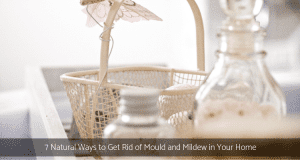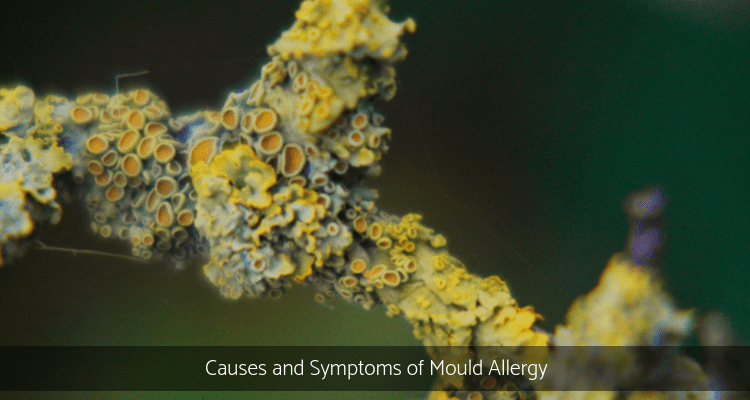If you suffer from allergies all year through, or if the allergies worsen during the damp months (rainy and winter), then you may be suffering from mould sensitivities or allergy.
The symptoms of mould sensitivities and allergy are similar to those of other allergies. Common mould allergy symptoms are coughing, watery eyes, headaches, and irritation of the skin, nose, eyes and throat.
The symptoms of mould allergy differ from person-to-person. Some people allergic to mould can also develop asthma. Symptoms of asthma include coughing, wheezing, shortness of breath and chest tightness. Other serious medical symptoms caused by mould include allergic fungal sinusitis , allergic bronchopulmonary aspergillosis, and hypersensitivity pneumonitis. People who are immuno compromised or those taking immuno suppressant medication may develop recurring skin infections.
 Causes of Mould Allergies
Causes of Mould Allergies
When someone allergic to mould inhales the airborne mould spores, their body reacts by producing anti-bodies to fight the invasion. This triggers the release of substances such as histamine which causes the person to experience mould allergy symptoms.
The four common types of moulds that cause allergies are Penicillium Notatum, Cladosporium Herbarum, Aspergillus Fumigatus, and Alternaria Alternata. It is possible for an individual to be allergic to one type of mould and not be allergic to the other moulds.
Factors That Put You at Risk of Mould Allergy
Mould grows wherever there is moisture and is found in both the external and internal environment. Mould grows on dead leaves, wood, and plants, fruits and vegetables, and on damp surfaces such as carpets, walls, wood, and paper.
When the temperature in houses decreases locally (e.g. at window panes, unheated sections of the house or poorly insulated walls), the relative humidity rises and accelerates microbial growth according to WHO (2009).
While mould is everywhere, there are certain factors that can put you at risk of developing mould allergy symptoms. These include –
1. Genetic history of allergies – If allergies and asthma runs in your family, you are more likely to develop mould allergies.
2. Your occupation – Certain occupations involve high exposure to mould. For instance, farming, dairy work, baking, carpentry, winemaking and furniture repair.
3. Living or working in a building with high humidity – Buildings and rooms that have relative humidity levels in excess of 60 percent can lead to proliferation of mould. Sydney is a prime example of a city with many mould problems.
4. Poor ventilation – Lack of ventillation creates ideal conditions for growth of mould. Spaces that lack ventilation such as the bathroom, kitchen, basement, and loft, are more likely to have signs of mould growth.
Mould Allergy Diagnosis
If you have any of the mould allergy symptoms, see an allergist for skin testing or a blood test to diagnose mould allergy. Before you meet the doctor list down the mould allergy symptoms you have been facing, when the symptoms occur ( for example certain times of the year, when you are at work or at home), and how often you experience the symptoms. You will also be asked about the family history of allergies, any other health problems, and medications you have been taking.
Mould Allergy Prevention
Recent epidemiological studies suggest that the adverse respiratory health effects caused by the inhalation of fungal propagules are substantial according to Dharmage et al. (2001). The study found high indoor fungal exposures were associated with infrequent ventilation or vacuuming, presence of pets, visible mould and old carpets.
Since moulds are common, it is difficult to prevent exposure to them. However, you can take several steps to reduce the presence of these triggers in your immediate environment.
HOW TO
Natural ways to get rid of mould and mildew in your home
Rising levels of dampness in your home during the summer and rainy season can spur growth of mildew and mould. The basement, attic, garage, cupboards, and bathrooms are particularly susceptible to developing fungi.

Indoor exposure to certain fungal genera in winter was a risk factor for asthma, atopy and respiratory symptoms in children accordng to Garret et al. (2001). On the other hand, no significant associations were seen between average viable or total spore concentrations and child health. Actual measurements of fungal spores predict health outcomes better than reported dampness.
Houses need to be specifically designed for primary prevention of respiratory problems associated with indoor allergen proliferation rather than using post hoc procedures to improve indoor climate and reduce allergen load as a secondary or tertiary preventive strategy according to Peat et al. (2007).
Towards healthier living, Carol Parr ♥
As Building Biologists, we have acquired knowledge of adverse health effects and recommend effective strategies to reduce occupants’ exposure by eliminating and controlling as many sources of pollutants in order to create healthy indoor living environments that are as exposure-free and natural as practically possible.
References
Peat, J., Dickerson, J. and Li, J. (2007). Effects of damp and mould in the home on respiratory health: a review of the literature. [online] Wiley Library Online. Available at: https://onlinelibrary.wiley.com/doi/abs/10.1111/j.1398-9995.1998.tb03859.x [Accessed 29 May 2015].
World Health Organisation. (2009). WHO Guidelines for Indoor Air Quality, Dampness and Mould. (Online). Available: http://www.euro.who.int/__data/assets/pdf_file/0017/43325/E92645.pdf
Dharmage, Bailey, Raven, Mitakakis, Thien, Forbes, Guest, Abramson and Walters, 2001. Prevalence and residential determinants of fungi within homes in Melbourne, Australia. [online] Wiley Library Online. Available at: https://onlinelibrary.wiley.com/doi/full/10.1046/j.1365-2222.1999.00640.x [Accessed 29 May 2015].
Peat, J., Dickerson, J. and Li, J., 2007. Effects of damp and mould in the home on respiratory health: a review of the literature. [online] Wiley Library Online. Available at: https://onlinelibrary.wiley.com/doi/abs/10.1111/j.1398-9995.1998.tb03859.x [Accessed 29 May 2015].
Author
-
We’re glad you’re here. We’re Carol and Tony, founders of one of the longest running Healthy Home Blogs in the world, Mitey Fresh Australia. We’ve been on this journey for the last 25 years and are passionate about helping families sift through health hazards and triggers like allergens, mould, water damage, chemicals and EMFs, to get clarity about what’s toxic and what’s not so they can create a healthy and happy home for their family they love. Each month, people visit this blog seeking focus on the health and wellbeing of their loved ones, sustainable and effective practice tips and guides, to help create and manage healthier indoor spaces, improve the built environment that is pleasing to the senses and support healthy living and nature, every day. Starting this blog was to help change people’s lives, one family at a time, and we can’t wait to share how its allowed us to stand next to you and show you how interpreting these synergies between buildings and the environment they are built in will impact upon the health and well-being of those who occupy them. Find out more about Healthy Homes and what this blog can do for you!





